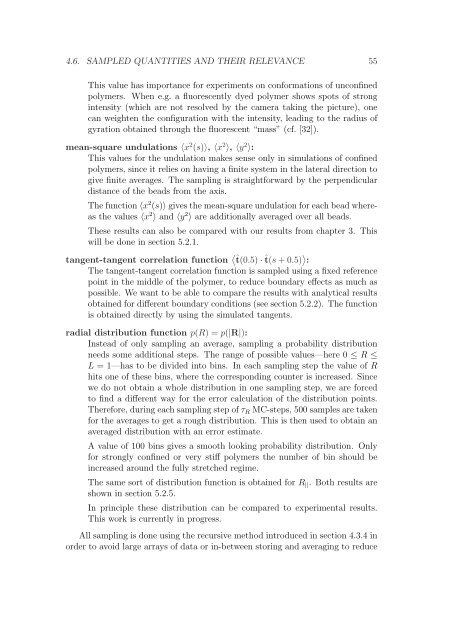Polymers in Confined Geometry.pdf
Polymers in Confined Geometry.pdf
Polymers in Confined Geometry.pdf
Create successful ePaper yourself
Turn your PDF publications into a flip-book with our unique Google optimized e-Paper software.
4.6. SAMPLED QUANTITIES AND THEIR RELEVANCE 55<br />
This value has importance for experiments on conformations of unconf<strong>in</strong>ed<br />
polymers. When e.g. a fluorescently dyed polymer shows spots of strong<br />
<strong>in</strong>tensity (which are not resolved by the camera tak<strong>in</strong>g the picture), one<br />
can weighten the configuration with the <strong>in</strong>tensity, lead<strong>in</strong>g to the radius of<br />
gyration obta<strong>in</strong>ed through the fluorescent “mass” (cf. [32]).<br />
mean-square undulations 〈x 2 (s)〉, 〈x 2 〉, 〈y 2 〉:<br />
This values for the undulation makes sense only <strong>in</strong> simulations of conf<strong>in</strong>ed<br />
polymers, s<strong>in</strong>ce it relies on hav<strong>in</strong>g a f<strong>in</strong>ite system <strong>in</strong> the lateral direction to<br />
give f<strong>in</strong>ite averages. The sampl<strong>in</strong>g is straightforward by the perpendicular<br />
distance of the beads from the axis.<br />
The function 〈x 2 (s)〉 gives the mean-square undulation for each bead whereas<br />
the values 〈x 2 〉 and 〈y 2 〉 are additionally averaged over all beads.<br />
These results can also be compared with our results from chapter 3. This<br />
will be done <strong>in</strong> section 5.2.1.<br />
tangent-tangent correlation function ˆt(0.5) · ˆt(s + 0.5) :<br />
The tangent-tangent correlation function is sampled us<strong>in</strong>g a fixed reference<br />
po<strong>in</strong>t <strong>in</strong> the middle of the polymer, to reduce boundary effects as much as<br />
possible. We want to be able to compare the results with analytical results<br />
obta<strong>in</strong>ed for different boundary conditions (see section 5.2.2). The function<br />
is obta<strong>in</strong>ed directly by us<strong>in</strong>g the simulated tangents.<br />
radial distribution function p(R) = p(|R|):<br />
Instead of only sampl<strong>in</strong>g an average, sampl<strong>in</strong>g a probability distribution<br />
needs some additional steps. The range of possible values—here 0 ≤ R ≤<br />
L = 1—has to be divided <strong>in</strong>to b<strong>in</strong>s. In each sampl<strong>in</strong>g step the value of R<br />
hits one of these b<strong>in</strong>s, where the correspond<strong>in</strong>g counter is <strong>in</strong>creased. S<strong>in</strong>ce<br />
we do not obta<strong>in</strong> a whole distribution <strong>in</strong> one sampl<strong>in</strong>g step, we are forced<br />
to f<strong>in</strong>d a different way for the error calculation of the distribution po<strong>in</strong>ts.<br />
Therefore, dur<strong>in</strong>g each sampl<strong>in</strong>g step of τR MC-steps, 500 samples are taken<br />
for the averages to get a rough distribution. This is then used to obta<strong>in</strong> an<br />
averaged distribution with an error estimate.<br />
A value of 100 b<strong>in</strong>s gives a smooth look<strong>in</strong>g probability distribution. Only<br />
for strongly conf<strong>in</strong>ed or very stiff polymers the number of b<strong>in</strong> should be<br />
<strong>in</strong>creased around the fully stretched regime.<br />
The same sort of distribution function is obta<strong>in</strong>ed for R||. Both results are<br />
shown <strong>in</strong> section 5.2.5.<br />
In pr<strong>in</strong>ciple these distribution can be compared to experimental results.<br />
This work is currently <strong>in</strong> progress.<br />
All sampl<strong>in</strong>g is done us<strong>in</strong>g the recursive method <strong>in</strong>troduced <strong>in</strong> section 4.3.4 <strong>in</strong><br />
order to avoid large arrays of data or <strong>in</strong>-between stor<strong>in</strong>g and averag<strong>in</strong>g to reduce













